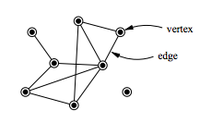
Photo from wikipedia
It is a common sense that both the formation and dissolution of links are the fundamental processes of link dynamics in network organization. Previous studies have analyzed the formation of… Click to show full abstract
It is a common sense that both the formation and dissolution of links are the fundamental processes of link dynamics in network organization. Previous studies have analyzed the formation of links with predicting missing links in current networks and new links in the future. However, little attention has been paid to the disappearing link prediction problem. In this paper, we investigate the disappearing link prediction problem. First, we define the disappearing link prediction in scientific collaboration networks. In contrary to the missing link prediction, we use structural similarity indices to estimate the disappearing links through dissimilarity of the node pairs. Then, we propose a novel method called modified preferential attachment (MPA) for predicting disappearing links. MPA is designed based on the preferential attachment considering both links’ weights and the different impacts of the nodes’ neighbor links. Finally, we evaluate the performance of MPA based on three real scientific collaboration networks extracted from Digital Bibliography & Library Project and American Physical Society datasets. Meanwhile, we explore the performance of the classical similarity methods on disappearing link prediction. The experiment results show that MPA achieves better performance than other classical similarity indices, which verifies the effectiveness of MPA.
Journal Title: IEEE Access
Year Published: 2018
Link to full text (if available)
Share on Social Media: Sign Up to like & get
recommendations!